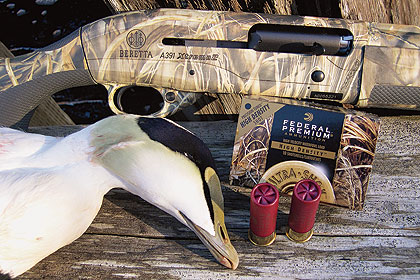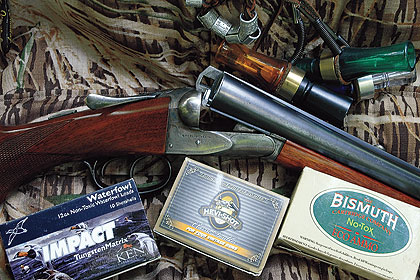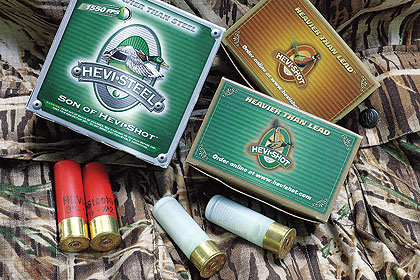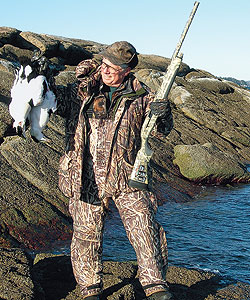No matter what gun you're shooting or your target, there's now a load to fit.
By Layne Simpson
Back when lead shot could be used for all hunting, the only decision hunters had to make was what size pellet was appropriate for a particular target. Then in 1991 the US Fish & Wildlife Service banned the use of lead not only for all waterfowl hunting, but for hunting upland birds adjacent to wetland areas as well.
 In addition to steel loads, Federal offers two exotic non-toxics, High Density (shown here), which performs about like lead, and Heavy Weight, which is considerably heavier than lead. |
The proper choices in shot sizes became a bit more confusing. That newfangled invention called steel shot we were required to use came in some of the same pellet sizes as lead shot but since it was lighter, a question remained -- what size should be used for, say, mallards shot at close range over decoys compared to pass-shooting Canada geese at longer ranges?
The American hunter is pretty darned good at working out solutions to problems and it was not long before it was discovered that moving up two pellet sizes beyond what had worked with lead would allow steel to deliver the same energy to yon feathered target. In other words, a No. 2 pellet made of steel would now do to a duck what a No. 4 lead pellet used to do. And if lead No. 2s had been your favorite medicine for geese, then steel BBs were just the ticket for reaching into the sky and bringing one of those big birds to the cook pot.
The increase in shot size made individual pellet energy delivery the same but the effective range of steel shot loads remained less than lead simply because fewer of the larger pellets could be squeezed into a shotshell of a particular size. Be that as it may, most waterfowlers eventually adapted.
Still, the sudden mandated use of nontoxic shot caught shotshell manufacturers with their pants down and as a result, those first steel shot loads to hit the market were sorry indeed.
 Remington's Wingmaster HD is composed mostly of tungsten and bronze, making it slightly heavier then lead shot. |
This, of course, is no longer true. While the performance of shells loaded with steel continues to lag far behind those of shells loaded with lead shot and the various types of nontoxic shot with densities close to or greater than that of lead, the better loads available today are leaps and bounds ahead of the ones we had back in the 1990s.
The biggest advantage steel has over other types of shot is its price, not to mention its availability at two different price levels. Examples of loads at the top of the heap are Federal Premium Ultra-Shok and Remington Nitro-Steel, while Sportsman Hi-Speed from Remington and Speed-Shok Waterfowl from Federal are representative of our lower priced spreads. The primary difference is in pellet quality with those in the higher priced ammo usually delivering more uniform patterns.
Also, the pellets are often plated to prevent rusting with the coating of zinc applied by Remington an example. In my opinion, both grades of ammo have their place in the hunting scheme of things. For up-close shooting of ducks over decoys, the cheaper stuff is plenty effective but for longer shots and for finishing off cripples, the more expensive ammo is well worth its price.
One of the more recent developments in steel is Black Cloud from Federal. Sixty percent of the steel pellets are of conventional shape while the remaining pellets wear a belt around their midsections. I remain skeptical about the odd-shaped pellets actually making any difference in performance but I am totally convinced the FliteControl wad elevates the ammo to a performance level above that of steel shot loads containing wads of more conventional designs.
Another interesting development is Hevi-Steel from Environ-Metal. Since the pellets are a bit heavier than regular steel pellets, a smaller size can be used for an increase in pattern density, which also results in increased effective range. For example, a load containing 11„2 ounces of No. 3 Hevi-Steel has approximately 237 pellets compared to 187 pellets for the same charge weight of No. 2 steel. Steel shot will always rule over waterfowl hunting simply because it is our least expensive option. Prices range from less than a buck per trigger squeeze for mart-special ammunition to just over a buck for premium-grade ammo.
 Unlike steel shot, these three nontoxics, Kent Tungsten-Matrix, Hevi-Shot Classic Doubles and Bismuth, will not harm the barrel of a vintage gun. |
As I mentioned earlier, the biggest shortcoming of steel is its low density compared to lead, which means that when pellets of the same size are used, steel delivers less energy to the target. This is why various shotshell manufacturers have spent a lot of time and money in the development of nontoxic shot with densities equal to lead. Various mixtures of metals and sometimes other materials have been used with one of the more common being tungsten. In addition to being extremely expensive, tungsten is quite heavy at 19.25 gms/cc compared to 11.1 gms.cc for pure lead.
When used in making shot it is in powder form and mixed with other materials.
Remington's Wingmaster HD shot, for example, is composed of 52 percent tungsten, 47 percent bronze and one percent iron. What they end up with is a shot with a density of 12.0 gms/cc, which is slightly heavier than lead. Xtended Range HD developed by Winchester and Hevi-Shot from Environ-Metal have about the same densities as the Remington shot and while all differ in composition, tungsten is their major ingredient.
 Hevi-Steel is heavier than steel shot and costs only slightly more while Hevi-Shot is heavier than and costs more than lead. |
In the past, Federal tried several nontoxic mixes (one being Tungsten-Polymer) but none were as good as the High Density and Heavyweight shot of today. Since High Density is only slightly heavier than lead shot, its performance
is about the same but Heavyweight is another matter entirely. Its density of 15.0 gms/cc (35 percent heavier than lead) allows the use of smaller pellets for a dramatic increase in pattern density.
As an example, a No. 4 Heavyweight pellet delivers the same amount of energy at 40 yards as a lead BB pellet which means that shells loaded with 11„4 ounces would contain 111 Heavyweight pellets compared to 62 BBs. In order to reach the same pellet count with lead BBs you would have to switch to the 31„2 inch shell and increase shot charge weight to 21„4 ounces. It takes no genius to figure out which would be the most comfortable to shoot.
Nontoxic shot made of steel and other more exotic mixes are just the ticket for modern guns but their extreme hardness rules out their use in guns built prior to the mid-1960s.
The same rule also applies so some guns built today with a lightweight English double being a good example. Bismuth was the first readily-available shot to be introduced that was soft enough to be used in vintage guns without damaging their barrels.
 Common eiders taken by the author with nontoxic shot. |
A mixture of bismuth and tin, it has a density of 9.70 gms/cc. Several hunting seasons have come and gone since I last used bismuth, but it was once my favorite nontoxic ammo for a couple of guns. While its density is higher than that of steel, it is a bit lower than lead so I used No. 5s on ducks with great satisfaction.
I have also shot a few ducks over decoys with the 28-gauge bismuth load and find it to be about as effective as the 23„4 inch 12-gauge shell loaded with steel shot. This one used to be marketed in the United States by the Bismuth Cartridge Company but is now offered by Pinnacle Ammunition.
Bismuth is not the only show in town for those who choose to hunt with guns of yesteryear. Tungsten-Matrix from Kent Cartridge of America has also been with us for quite a few years. I tried it on ducks in Uruguay before it became approved for use on waterfowl in the United States and through the years I have used a lot of it with complete satisfaction.
It is made by binding tungsten powder together with a polymer material and with a density of 10.6 gms/cc, it is so close to lead in weight you will think you are shooting lead. My 16-gauge L.C. Smith loves it and I am glad I have a good supply because Tungsten-Matrix is presently available only in various 12- and 20-gauge loadings.
Newest nontoxic on the block for vintage guns is Classic Doubles from Environ-Metal.
But don't let the name fool you -- it is just as suitable for that old Winchester Model 12 pump gun or Browning A5 autoloader gathering dust in the corner.
With a gravimetric density of about 10 gms/cc, it is considerably heavier than steel and not far behind lead shot in weight and yet its softness makes it kind and gentle to the barrels of older guns. They won't say exactly how Classic Doubles pellets are formed but the process basically entails the use of high pressure to form a mixture of tungsten, nickel and iron into pellets of the desired size.
I discovered how good Classic Doubles ammo is during opening week of the 2007 Iowa pheasant season. I used the 23„4 inch load with 11„8 ounces of No. 5s and anytime I pulled the trigger of my Fox Sterlingworth while its muzzles were pointed where a ringneck was about to be rather than where it used to be, it was a dead bird.
Most of the shooting was inside 30 yards but one bird, flushed by another hunter, had its afterburner going full bore as it offered me a left-to-right crossing shot. As soon as I pulled the first trigger I knew I had not allowed enough lead so I quickly pushed the muzzle further ahead and stroked the trigger on the Extra Full barrel. It didn't seem all that far away but it took me 58 long paces to get to the dead rooster.






